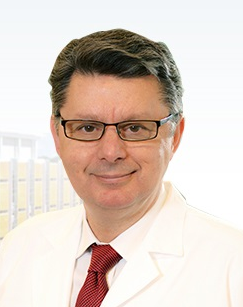ALERT!
This site is not optimized for Internet Explorer 8 (or older).
Please upgrade to a newer version of Internet Explorer or use an alternate browser such as Chrome or Firefox.
Featured Profile and Interview With Konstadinos Plestis, MD

Professor Konstadinos Plestis is a cardiothoracic surgeon at Jefferson Health, professor of surgery at Sidney Kimmel Medical College, and director of the Jefferson Aortic Center in Pennsylvania. After receiving his MD from the Aristotelian University Medical School in Thessaloniki, Greece, Dr Plestis moved to the United States to undertake a general surgery residency at the Brooklyn Hospital Center, New York. He followed that with a vascular surgery residency at Baylor College of Medicine in Houston before returning to the East Coast to complete a cardiothoracic surgery residency at Montefiore Medical Center/Albert Einstein College of Medicine in New York.
Dr Plestis’s clinical interests include aortic valve repair, repair of aneurysms of the root, ascending, arch, descending and thoracoabdominal aorta and valve surgery. He has pioneered the mini-sternotomy approach for all proximal aortic operations. His research is focused on outcome analysis of operations involving thoracic aortic aneurysms and aortic valve repair, evaluation of the impact of mini-sternotomy approach for proximal aortic surgery on outcomes and quality of life, optimization of mini-sternotomy techniques for proximal aortic surgery, development of cerebral and spinal cord protection strategies for aortic arch and thoracoabdominal operations, and evaluation of different myocardial protection strategies for extensive aortic operations. Dr Plestis is a member of The Society of Thoracic Surgeons, Eastern Cardiothoracic Surgical Society, Hellenic Cardiovascular and Thoracic Society, International Society for Minimally Invasive Cardiothoracic Surgery, and the Society for Heart Valve Disease. He is a member of CTSNet and is the CTSNet Guest Editor for the Surgical Management of Acute Aortic Dissections: Tricks and Tips to Simplify the Operation series.
Dr Plestis and his wife, a pediatric endocrinologist, currently live in Pennsylvania and have two grown children. In his spare time, Dr Plestis travels, plays tennis, and enjoys a game of chess or bridge.
Catherine Joyce for CTSNet:
CTSNet:You received your medical degree in Greece and then completed your residency in the United States. What was the most interesting or valuable aspect of pursuing training in a different country?
KP: I came to Boston as a medical student from Greece for a three-month clerkship in 1986 and fell in love with the way that medicine is taught and practiced in the United States. The quality of training, the commitment to excellence, and the continuous pursuit of superior training is unique to this country. Also, practicing cardiothoracic surgery in the USA is a unique privilege that I have been lucky enough to experience firsthand. I have never regretted the decision to come to this wonderful country, complete my residency and fellowship in great institutions, and have the opportunity to practice here.
CTSNet: What is the biggest challenge facing aortic dissection surgery right now?
KP: Despite significant diagnostic and technical advances in the last two decades, the mortality and complication rates remain substantial for patients who suffer from aortic dissections. The technical aspects of these operations remain challenging even for experienced aortic surgeons. Nonetheless, many of these operations are performed by non-aortic surgeons, and I hope that the [Surgical Management of Acute Aortic Dissections: Tricks and Tips to Simplify the Operation] series of videos will be able to provide valuable technical information to help with the management of these complex operations. Also, complex aortic dissections with involvement of the carotid and visceral vessels may lead to devastating complications, such as stroke and bowel necrosis, that may further complicate the management of these patients. This matter further demonstrates the need for identification and strict follow up of patients with aortic aneurysms and prompt intervention to avoid these disastrous complications.
CTSNet: Technical skill is obviously important for surgeons, but can you address the importance of leadership skills and the capacity to foster the surgical team’s success?
KP: An important issue is the need for a multidisciplinary approach in the management of patients with acute aortic dissections, involving cardiac surgeons, vascular surgeons, interventional radiologists, and other subspecialties. The cardiac surgeon, as the first physician usually responding to these emergency situations, has an important leadership role to educate the staff in the operating room and wards, as well as to assemble and lead the team of physicians, residents, and advanced practice providers that provide direct patient care during these stressful operations. Fostering a team approach to the management of these emergencies has a direct impact in improving outcomes.
CTSNet: How does your clinical research complement or influence your approach to patient care?
KP: Clinical research in aortic surgery has guided my practice over the last 20 years. My specific focus is long-term outcome research that allows me to understand the impact of aortic procedures on overall survival and quality of life, and translate research findings to everyday practice. Having an aortic registry and collecting operative and long-term data on various aortic operations gives me the ability to continuously reassess and compare clinical practices, while I strive to improve the surgical techniques in relation to and overall management of these challenging patients.
CTSNet: If you had a magic wand to create the next innovation in CT surgery, what would it be?
KP: As far as cardiac and aortic surgery is concerned, I would like to see improvements in technology and techniques that will allow us to produce outstanding outcomes in the least invasive way. Also, I would like to see how we can further reduce the postoperative pain and discomfort, and restore the quality of life to these patients back to normal as soon as possible.
CTSNet: What is your favorite thing about CTSNet?
KP: CTSNet is a great platform for cardiac surgeons. Personally, I enjoy immensely the video section. It is a wonderful way for a surgeon to enrich his surgical armamentarium by observing the way that other surgeons deal with complicated surgical problems.
CTSNet: Thank you, Dr Plestis.




